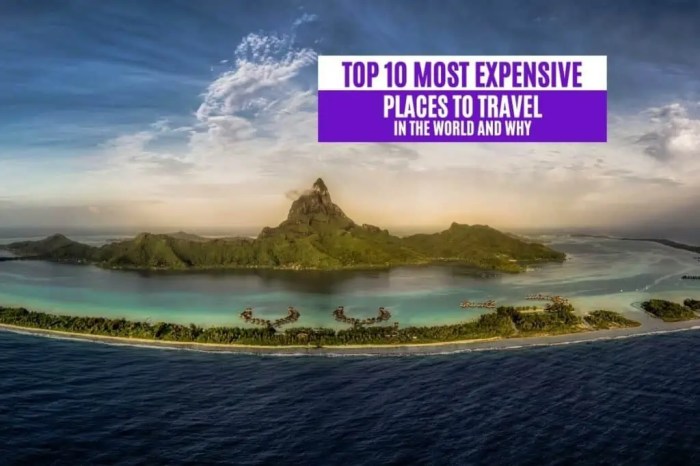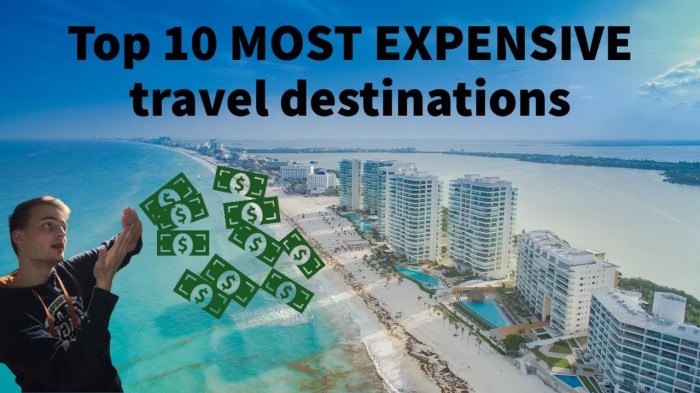Most Expensive Travel Destinations beckon with unparalleled luxury and unique experiences, but at a significant cost. This exploration delves into the factors driving these exorbitant prices, from exclusive accommodations and bespoke activities to the impact of currency fluctuations and hidden transportation expenses. We’ll examine top destinations across the globe, comparing luxury and budget travel options to paint a clear picture of what makes a trip truly extravagant.
Understanding the cost breakdown is crucial for planning, whether you’re aiming for a lavish escape or seeking ways to maximize your budget in these high-end locations. We’ll analyze various accommodation types, transportation choices, and seasonal price variations, providing insights into smart travel strategies. Ultimately, this guide aims to equip you with the knowledge to navigate these exclusive travel destinations effectively, regardless of your spending preferences.
Defining “Most Expensive”
The cost of travel to a destination is a multifaceted issue, influenced by a complex interplay of factors beyond simply the price of a plane ticket. Understanding what contributes to a destination’s “most expensive” status requires examining several key elements impacting the overall travel expenditure. This analysis will delve into these factors, providing concrete examples to illustrate their influence.
Factors Contributing to High Travel Costs
Several key factors significantly influence the overall cost of travel to a particular destination. These factors often work in concert, resulting in dramatically higher expenses compared to other, more affordable locations.
- Accommodation Costs: Luxury hotels in prime locations, offering exceptional amenities and service, command significantly higher prices. For example, a night at the Burj Al Arab Jumeirah in Dubai can cost thousands of dollars, while a comparable stay in a less exclusive hotel might cost a fraction of that.
- Transportation Expenses: Private jet travel, first-class airfare, and chauffeured car services contribute heavily to overall costs. A private jet charter between London and New York can easily cost tens of thousands of dollars, while an economy flight might cost only a few hundred.
- Activity and Entertainment Costs: High-end dining experiences, exclusive tours, and luxury shopping opportunities in popular destinations like Monaco or St. Barts inflate travel budgets. A Michelin-starred dinner in Paris can cost hundreds of dollars per person, whereas a simple bistro meal might be a tenth of the price.
- Visa and Permit Fees: Certain destinations require specific visas or permits that can be expensive to obtain, adding significant costs to the overall travel budget. For example, some expedition permits to remote areas like Antarctica can cost thousands of dollars.
- Taxes and Fees: Destinations may impose various taxes and fees on tourists, such as tourist taxes, airport departure taxes, and other levies, which add to the overall cost. These taxes can vary widely depending on the destination and the type of services used.
Impact of Currency Exchange Rates
Currency exchange rates play a significant role in determining the perceived cost of travel. Fluctuations in exchange rates can dramatically impact the budget.For instance, if the US dollar strengthens against the Euro, an American traveler will find their trip to France cheaper than if the dollar weakens. Conversely, if the Euro strengthens, the same trip will appear more expensive to the American traveler.Hypothetically, let’s say a hotel room in Paris costs €100.
If the exchange rate is $1.10 USD per Euro, the room costs $110 USD. However, if the exchange rate shifts to $1.20 USD per Euro, the same room now costs $120 USD, representing a 10% increase in cost for the American traveler, despite the actual price in Euros remaining unchanged.
Luxury vs. Budget Travel Cost Comparison
The difference between luxury and budget travel to the same destination can be substantial. The following table illustrates this contrast:
| Destination | Luxury Cost (USD) | Budget Cost (USD) | Difference (USD) |
|---|---|---|---|
| Paris, France (7 days) | 10,000 | 2,000 | 8,000 |
| Maldives (7 days) | 15,000 | 3,000 | 12,000 |
| Kyoto, Japan (7 days) | 7,000 | 1,500 | 5,500 |
| New York City (7 days) | 5,000 | 1,000 | 4,000 |
Top Destinations
Luxury travel, the pursuit of unparalleled experiences, often comes with a hefty price tag. This section delves into the world’s most expensive travel destinations, examining the factors contributing to their high costs and offering a comparative overview of expenses across various regions.
Consistently Expensive Destinations, Most Expensive Travel Destinations
Five destinations consistently feature among the world’s priciest: Switzerland, Monaco, the Maldives, Seychelles, and Bora Bora. Switzerland’s high cost stems from its strong currency, luxurious accommodations, and upscale shopping. Monaco’s exclusivity, coupled with its high concentration of luxury goods and services, contributes to its exorbitant prices. The Maldives and Seychelles boast overwater bungalows and private villas, commanding premium rates.
Bora Bora’s remote location and limited accessibility add to the cost of travel and accommodation. These factors, among others, create a consistently high cost of living and travel for these destinations.
Global Destinations and Cost Estimates
The following list provides ten destinations categorized by region, offering a brief description and a high-level cost estimate for a week-long trip for two people, excluding flights. These estimates are averages and can vary significantly based on travel style and season.
- Europe:
- Switzerland (Zermatt): Picturesque alpine village; expect to spend $10,000+. The cost reflects high-end accommodations and dining.
- France (Paris): Iconic city with luxury shopping and fine dining; $7,000 – $12,000 depending on the level of luxury.
- Italy (Florence): Renaissance art, culinary delights, and opulent hotels; $6,000 – $9,000.
- Asia:
- Japan (Tokyo): Modern metropolis with Michelin-starred restaurants and exclusive experiences; $7,000 – $10,000.
- Maldives (Malé): Overwater bungalows and pristine beaches; $8,000 – $15,000+ (highly variable).
- North America:
- United States (New York City): Bustling city with world-class dining and entertainment; $6,000 – $10,000.
- Oceania:
- Australia (Sydney): Stunning harbor city with a vibrant culinary scene; $5,000 – $8,000.
- Africa:
- Seychelles (Mahé): Tropical paradise with secluded beaches and luxurious resorts; $8,000 – $12,000+.
- South America:
- Chile (Patagonia): Breathtaking landscapes and adventurous activities; $6,000 – $9,000.
Comparative Daily Costs
Imagine a visual representation, a bar chart perhaps, comparing the average daily cost for two people in three high-end destinations: Paris, the Maldives, and Zermatt.The chart would show that the Maldives has the highest average daily cost, significantly exceeding that of Paris and Zermatt. The Maldives’ higher cost is primarily driven by extremely expensive accommodation in overwater bungalows or private villas.
Paris would show a moderate daily cost, reflecting a balance between luxury accommodations, fine dining, and various activities. Zermatt, while still expensive, would exhibit a slightly lower daily cost compared to Paris, attributable to the overall cost of living and activities in the Swiss Alps. The cost breakdown would include significant portions allocated to accommodation in all three, followed by dining and activities, with activities potentially contributing more significantly to the overall cost in Zermatt and Paris.
Accommodation and Activities

Source: themostexpensive.org
Understanding the cost of a luxury trip requires a detailed look at accommodation and activities. These two elements often represent the largest portion of your overall budget, significantly impacting the total expense of your journey. This section will break down the costs associated with a sample itinerary, explore the effects of seasonality, and compare various accommodation options in a high-cost destination.
Sample Five-Day Itinerary: Luxury Trip to the Maldives
The following itinerary illustrates a potential five-day trip to the Maldives, a destination known for its high prices. This example focuses on a luxurious experience and provides a realistic cost breakdown. Note that prices are estimates and can vary depending on the specific resort, time of year, and availability.
- Accommodation (5 nights): Overwater bungalow at a luxury resort (e.g., Four Seasons Landaa Giraavaru). Estimated cost: $3,000 – $5,000 per night. Total: $15,000 – $25,000.
- Activities (5 days): This could include private sunset cruises ($500-$1000 per cruise), scuba diving excursions ($200-$300 per excursion), spa treatments ($200-$500 per treatment), and private dinners on the beach ($300-$500 per dinner). Total estimated cost: $3,000 – $5,000.
- Food and Beverage (5 days): This includes meals at the resort’s restaurants, mini-bar expenses, and drinks. Expect to spend around $500-$1000 per day. Total: $2,500 – $5,000.
- Flights (round trip): International flights to Malé, the capital of the Maldives, can vary greatly depending on your origin and time of year. Expect to pay anywhere from $1,500 to $5,000 or more for a round trip business or first-class ticket.
- Transfers: Seaplane transfers from Malé to most resorts are necessary and can cost around $1,000-$2,000 round trip.
Seasonality’s Impact on Travel Costs: Maldives Example
The Maldives experiences two distinct seasons: a dry season (November to April) and a wet season (May to October). The dry season is significantly more expensive due to higher demand. For example, a luxury overwater bungalow might cost $5,000 per night during peak season (December-February) but only $3,000 during the shoulder seasons (November or April). Similarly, flights and activities will also be more expensive during the peak season.
The wet season offers lower prices but might include occasional rain showers.
Accommodation Cost Comparison: London, England
London offers a wide range of accommodation options, reflecting its status as a global hub. The following table compares the average nightly rates for different accommodation types:
| Accommodation Type | Average Nightly Rate | Amenities | Pros/Cons |
|---|---|---|---|
| Five-Star Hotel (e.g., The Ritz London) | $1,500 – $3,000+ | Luxurious rooms, multiple restaurants, spa, concierge service | Pros: Unparalleled luxury and service. Cons: Extremely expensive, can feel impersonal. |
| Boutique Hotel (e.g., The Zetter Hotel) | $500 – $1,000 | Stylish rooms, personalized service, often located in prime areas | Pros: Unique experience, excellent service. Cons: Fewer amenities than five-star hotels. |
| Airbnb (Luxury Apartment) | $300 – $800 | Kitchen facilities, more space than hotel rooms, local experience | Pros: More affordable, greater space and privacy. Cons: Lack of hotel services, potential for variability in quality. |
Transportation and Accessibility
Transportation costs significantly impact the overall budget of luxury travel. While accommodation and activities often grab the headlines, the hidden expenses associated with getting around can quickly escalate the total cost, sometimes exceeding the price of accommodation itself. This section will explore how various transportation methods and accessibility issues contribute to the high price tag of visiting exclusive destinations.
Transportation Costs: Flights, Transfers, and Local Travel
Flights to exclusive destinations are often significantly more expensive than flights to more common tourist hubs. A first-class or business-class ticket to a remote private island resort in the Maldives, for instance, can easily cost several thousand dollars more than an economy ticket to a major city. Furthermore, private transfers from airports to luxury resorts, often involving speedboats or helicopters, add substantial costs.
Consider a private helicopter transfer from the Seychelles International Airport to a secluded resort on a private island; this alone can easily cost several hundred, if not thousands, of dollars. Even within the destination, local transportation can be pricey. Hiring a private car with a driver for sightseeing in places like St. Barts or Capri can accumulate considerable expenses over a week-long trip.
The cost of using local taxis or ride-sharing services, while potentially cheaper than private car hire, still adds up, particularly when exploring multiple locations daily.
Visa Requirements and Travel Insurance Costs
Securing the necessary visas for high-end destinations can be a complex and expensive process. Some countries charge significant visa application fees, and processing times can necessitate expedited services, which come with additional costs. For example, applying for a visa to enter certain countries in the Middle East or Africa might involve substantial fees and potentially require the use of a visa processing agency, increasing the overall expense.
Furthermore, comprehensive travel insurance, particularly crucial for high-value trips, is another often overlooked expense. Policies covering medical emergencies, trip cancellations, and lost luggage in expensive destinations are considerably more expensive than standard travel insurance. A comprehensive travel insurance policy for a luxury trip to a remote location could cost several hundred dollars, depending on the length of the stay and the level of coverage.
Accessibility and Transportation Budget Impact
Limited or inadequate public transportation in many luxury destinations often necessitates the use of private transportation, significantly impacting the travel budget. This lack of accessible public transport disproportionately affects the overall cost.
- Remote Island Resorts: Reaching many exclusive island resorts requires private boat or helicopter transfers, adding substantial costs compared to destinations with readily available public ferries or buses.
- Mountainous Regions: Exploring mountainous regions with limited road infrastructure might require hiring four-wheel-drive vehicles or even utilizing helicopter tours, leading to higher transportation costs than destinations with well-developed public transport systems.
- Luxury Villas in Rural Areas: Accessing luxury villas located in remote or rural areas often involves private car hire or chauffeured services, significantly increasing the overall travel expense compared to hotels located in city centers with easy access to public transport.
Luxury Experiences
The exorbitant price tags associated with the world’s most expensive travel destinations aren’t simply about accommodation; they encompass a curated collection of exclusive experiences designed to pamper and indulge. These experiences often blend unparalleled luxury with unique cultural immersion or access to otherwise unavailable opportunities. Understanding these experiences is key to grasping the true cost of high-end travel.
Several factors contribute to the high cost of these luxury experiences, resulting in a significant difference between a standard trip and a truly opulent one. This section will explore three such experiences, comparing their pricing across different destinations and examining the underlying reasons for their high cost.
Luxury Experiences Offered in Expensive Destinations
Three unique luxury experiences, available in multiple high-end travel destinations, exemplify the extravagance often associated with such trips. These include private helicopter tours of iconic landscapes, bespoke culinary journeys featuring Michelin-starred chefs, and exclusive access to private islands or luxury villas.
Private helicopter tours offer breathtaking views and unparalleled access to otherwise inaccessible locations. Bespoke culinary journeys provide immersive gastronomic experiences, often involving private dining with renowned chefs. Exclusive access to private islands or luxury villas provides ultimate privacy and personalized service, creating an unforgettable experience. The cost of these experiences varies significantly depending on location, duration, and the level of customization.
Price Comparison of Similar Luxury Experiences
The table below compares the cost of similar luxury experiences across two different expensive destinations, illustrating the variation in pricing. These prices are estimates based on market research and may vary depending on specific providers and seasonal demands.
| Experience | Destination 1 Cost (e.g., Maldives) | Destination 2 Cost (e.g., French Riviera) | Key Differences |
|---|---|---|---|
| Private Helicopter Tour (2 hours) | $5,000 – $10,000 | $4,000 – $8,000 | Maldives tours often include island hopping and unique perspectives of atolls. French Riviera tours may focus on coastal scenery and glamorous towns. |
| Bespoke Culinary Journey (3 days) | $15,000 – $30,000 | $12,000 – $25,000 | Maldives experiences might emphasize fresh seafood and local spices. French Riviera experiences could highlight Provençal cuisine and regional wines. |
| Exclusive Private Island/Villa Rental (7 days) | $50,000 – $100,000+ | $40,000 – $80,000+ | Maldives villas often feature overwater bungalows and stunning ocean views. French Riviera villas may offer proximity to charming villages and cultural attractions. |
Factors Driving the High Cost of Exclusive Luxury Travel Experiences
The exceptionally high cost of these experiences stems from several key factors:
- Rarity and Exclusivity: Access to these experiences is often limited, creating a high demand and driving up prices. Many involve private access to locations or services not readily available to the general public.
- Personalized Service: These experiences typically involve a high level of personalized service, including dedicated concierge teams, private chefs, and personal butlers. This level of attention requires significant staffing and resources.
- High-Quality Resources and Amenities: The experiences utilize high-quality materials, equipment, and amenities, contributing significantly to the overall cost. This might include private jets, luxury yachts, Michelin-starred chefs, and bespoke handcrafted items.
Concluding Remarks

Source: alojapan.com
Exploring the world’s most expensive travel destinations reveals a fascinating interplay between luxury, exclusivity, and accessibility. While the price tags can be daunting, understanding the contributing factors – from premium accommodations and unique experiences to hidden transportation and visa costs – empowers travelers to make informed decisions. Whether you’re dreaming of a lavish escape or simply curious about the ultimate in travel extravagance, this journey has provided a comprehensive overview of what shapes the cost of these extraordinary adventures.
FAQ Guide: Most Expensive Travel Destinations
What are some ways to reduce the cost of travel to expensive destinations?
Consider traveling during the off-season, opting for budget-friendly accommodation like Airbnb, utilizing public transportation, and engaging in free or low-cost activities.
Are there any destinations that offer luxury experiences at more affordable prices than others?
Some destinations in Southeast Asia and South America offer luxurious experiences at comparatively lower prices than those in Europe or North America. Research is key to finding value.
How much travel insurance should I get for an expensive trip?
The amount of travel insurance needed depends on the trip’s cost and your personal risk tolerance. Consider comprehensive coverage that includes medical emergencies, trip cancellations, and lost luggage.




